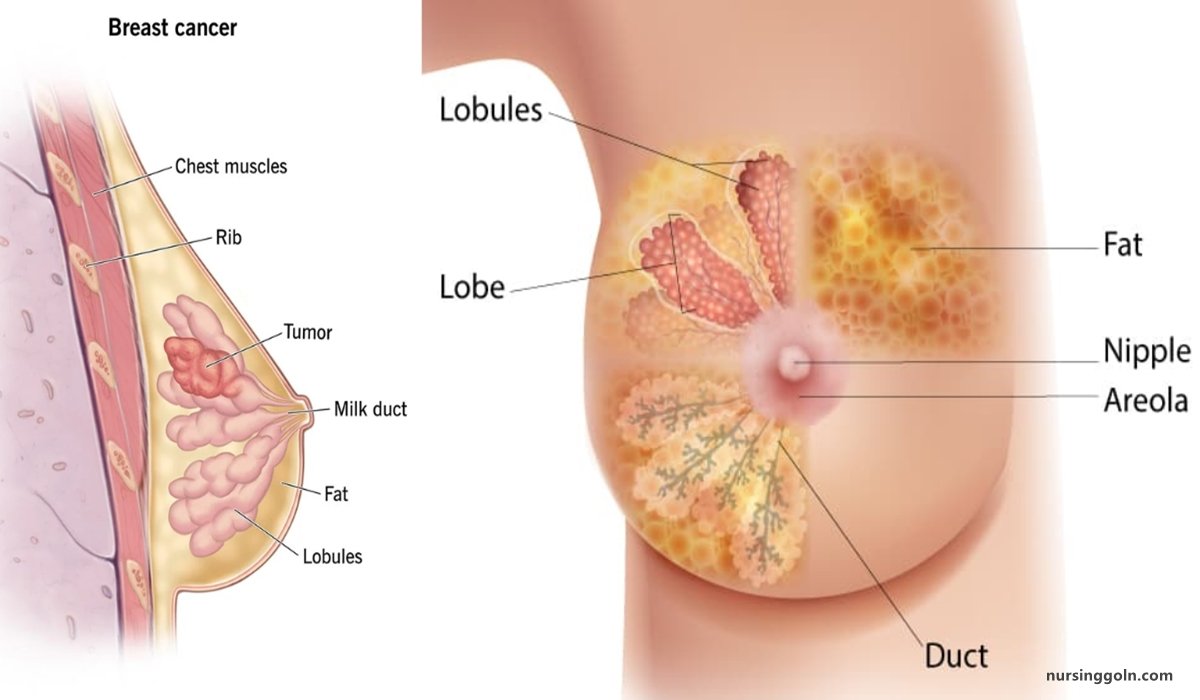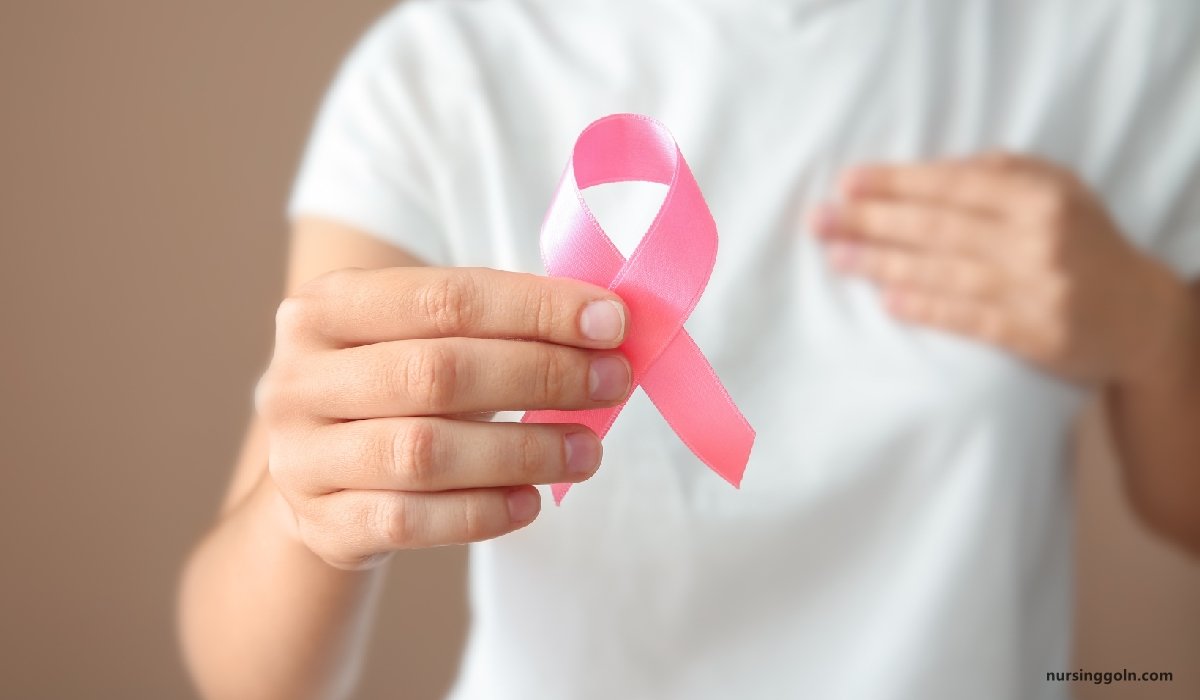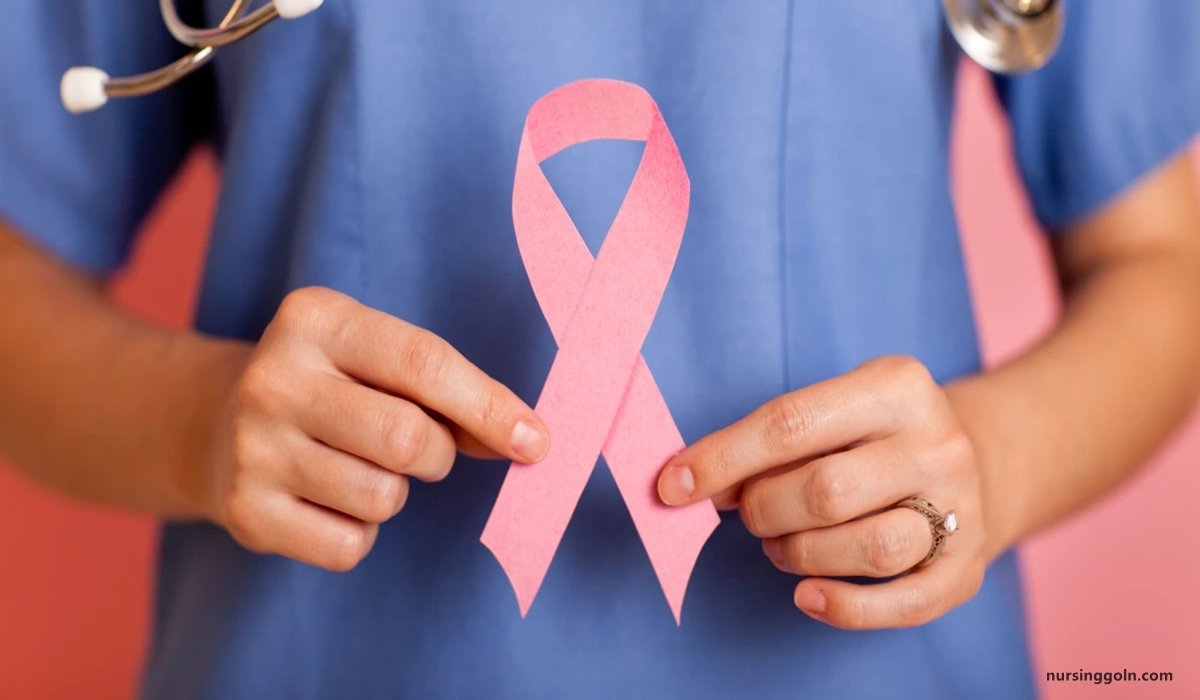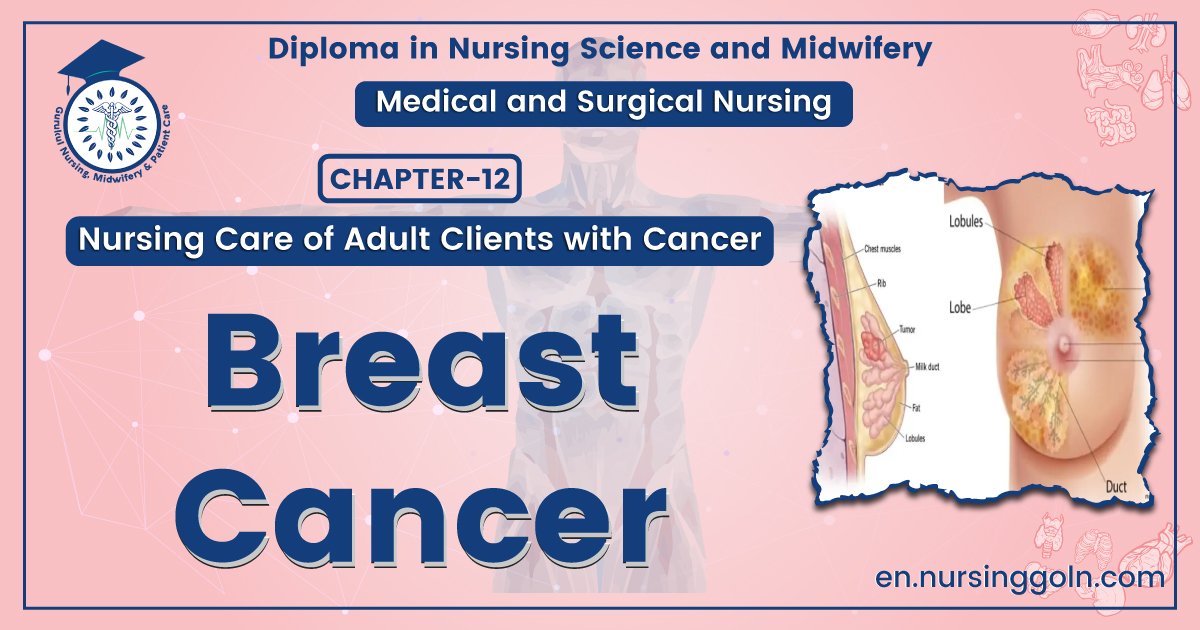Breast cancer – This course is designed to understand the concept of community health nursing: nurses’ roles and interventions in family health, school health, occupational health, environmental health, elderly health care, gender issues, disaster management and principles and terminology of epidemiology. The aim of the course is to acquire knowledge and skills in community health nursing.
Breast cancer
Breast-cancer starts when cells in the breast begin to grow out of control. These cells usually form a tumor that can often be seen on an x-ray or felt as a lump.

The tumor is malignant (cancer) if the cells can grow into (invade) surrounding tissues or spread (metastasize) to distant areas of the body. Breast-cancer occurs almost entirely in women, but men can get Breast-cancer, too.
Definition of Breast-cancer:
Breast-cancer is a malignant tumor (a collection of cancer cells) arising from the cells of the breast. Although Breast-cancer predominantly occurs in women, it can also affect men.
Sign and Symptoms of Breast-cancer:
The first symptoms of Breast-cancer are usually an area of thickened tissue in the breast, or a lump in the breast or in an armpit.
Other symptoms include:
- A pain in the armpits or breast that does not change with the monthly cycle
- Pitting or redness of the skin of the breast, like the skin of an orange
- A rash around or on one of the nipples
- A discharge from a nipple, possibly containing blood
- A sunken or inverted nipple
- A change in the size or shape of the breast
- Peeling, flaking, or scaling of the skin on the breast or nipple
Most lumps are not cancerous, but women should have them checked by a health care professional
Stages of Breast-cancer
Cancer is staged according to the size of the tumor and whether it has spread to lymph nodes or other parts of the body.
There are different ways of staging Breast-cancer. One way is from stage 0 to 4, but these may be broken down into smaller stages.
1. Stage 0: Known as ductal carcinoma in situ (DCIS), the cells are limited to within a duct and have not invaded surrounding tissues.
2. Stage 1: At the beginning of this stage, the tumor is up to 2 centimeters (cm) across and it has not affected any lymph nodes.
3. Stage 2: The tumor is 2 cm across and it has started to spread to nearby nodes.
4. Stage 3: The tumor is up to 5 cm across and it may have spread to some lymph nodes.
5. Stage 4: The cancer has spread to distant organs, especially the bones, liver, brain, or lungs.
Types of Breast-cancer:
1. In situ carcinoma:
- Ductal carcinoma in situ
- Lobular carcinoma in situ
2. Invasive carcinoma:
- No special type carcinoma(“Ductal carcinoma)- most common
- Lobular carcinoma
- Tubular/cribriform carcinoma
- Mucinous (Colloid) carcinoma
- Medullary carcinoma
- Metaplastic carcinoma.
3. The following are other uncommon types of Breast-cancer:
- Papillary carcinoma
- Phyllodes tumor
- Angiosarcoma
- Tubular carcinoma

Risk Factors of Breast cancer:
Factors that are associated with an increased risk of Breast-cancer include:
1. Being female. Women are much more likely than men are to develop Breast-cancer.
2. Increasing age. The risk of Breast-cancer increases as age. (Uncommon below 35 years and mainly common after 65 years)
3. A personal history of breast conditions. If patient had a breast biopsy that found lobular carcinoma in situ (LCIS) or atypical hyperplasia of the breast, he has an increased risk of Breast-cancer.
4. A personal history of breast cancer.
5. A family history of breast cancer. If patient mother, sister or daughter was diagnosed with breast cancer, particularly at a young age, patient risk of breast cancer is increased. Still, the majority of people diagnosed with breast cancer have no family history of the disease.
6. Inherited genes that increase cancer risk.
7. Radiation exposure. If patient received radiation treatments to his chest as a child or young adult, risk of breast cancer is increased.
8. Obesity. Being obese increases the risk of breast cancer.
9. Beginning your period at a younger age. Beginning period before age 12 increases risk of breast cancer.
10. Beginning menopause at an older age.
11. Having first child at an older age. Women who give birth to their first child after age 30 may have an increased risk of breast cancer.
12. Having never been pregnant. Women who have never been pregnant have a greater risk of breast cancer than do women who have had one or more pregnancies.
13. Postmenopausal hormone therapy. Women who take hormone therapy medications that combine estrogen and progesterone to treat the signs and symptoms of menopause have an increased risk of breast cancer. The risk of breast cancer decreases when women stop taking these medications.
14. Drinking alcohol. Drinking alcohol increases the risk of breast cancer.

Prognosis of Breast Cancer:
Five-year survival rates for breast cancer by stage
| Tumour stage | Stage definition | 5-year survival (%) |
| Stage I | Tumour <2 cm, no lymph nodes | 96 |
| Stage II | Tumour 2-5 cm, and or mobile axillary lymph nodes | 81 |
| Stage III | Chest wall or skin fixation and or fixed axillary lymph nodes | 52 |
| Stage IV | Metastasis | 18 |
Treatment of Breast Cancer:
Treatment will depend on:
Chemotherapy can be an option for breast cancer.
- The type of breast cancer
- The stage of the cancer
- Sensitivity to hormones
- The patient’s age, overall health, and preferences
The main options include:
1. Radiation therapy: Indicated in brain or bone metastases or spinal cord compression
2. Surgery: Lumpectomy, mastectomy
3. Biological therapy, or targeted drug therapy
4. Hormone therapy/ Estrogen therapy: Patients whose tumours are found to be positive for ER or PR
5. Chemotherapy: Patients with negative ER or PR

Prevention of Breast Cancer:
There is no sure way to prevent breast cancer, but some lifestyle decisions can significantly reduce the risk of breast and other types of cancer.
These include:
- Avoiding excess alcohol consumption
- Following a healthy diet with plenty of fresh fruit and vegetables
- Getting enough exercise
- Maintaining a healthy body mass index (BMI)
Women should think carefully about their options for breast-feeding and the use of HRT following menopause, as these can affect the risk.
Preventive surgery is an option for women at high risk.
Read more:
